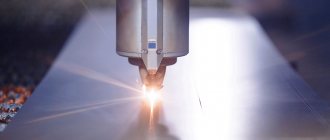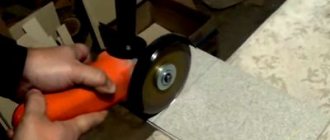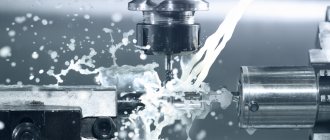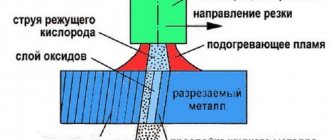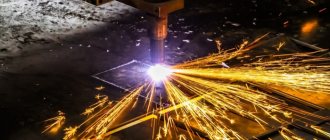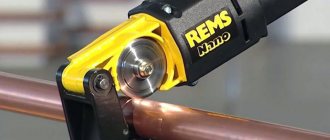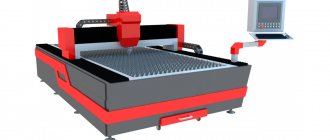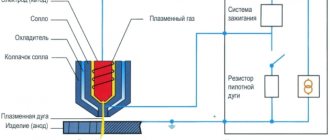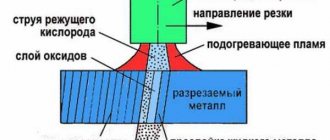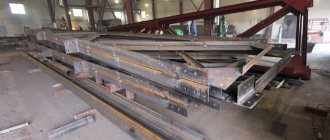Methods for cutting stainless steel
The material in question belongs to alloy types of steel, which are not afraid of contamination and exposure to liquids, since they do not become rusty. The composition of the steel is complemented by a high content of chromium, as well as hardeners - titanium, tungsten, iron molybdenides. Thanks to this, on the one hand, the durability of the metal is achieved by increasing strength; on the other hand, it complicates the cutting process. However, there are several ways to qualitatively divide metal into small pieces.
There are two cutting groups:
- mechanical (the workpiece is cut with a sharp hand tool);
- thermal (due to exposure of the metal to high temperatures, leading to its melting).
The advantage of the first method is that the master will not need expensive equipment. The disadvantage is the need for physical force and a lot of time. Therefore, thermal cutting methods are becoming very popular today.
These include:
- gas arc cutting;
- by electrical erosion;
- waterjet;
- laser;
- plasma.
The features of each type of material processing are discussed below.
Oxygen cutting
Better known as “gas arc cutting”. As in other cases, processing involves the use of special equipment. Its working part - the arc - comes into contact with the workpiece, after which deformation of the cut layer occurs.
Arc cutting is performed with consumable and non-consumable electrodes. The first includes steel, the second - graphite. To increase the efficiency of work, air (air-arc cutting) or oxygen (oxygen-arc cutting) is supplied to the arc zone.
The advantages of the method are the availability of equipment and the low cost of it (or work). But there are more shortcomings. Among them:
- violation of the integrity of the metal;
- poor cut quality;
- low productivity.
The process of arc cutting stainless steel is now considered obsolete as more efficient methods have replaced it.
How to cut a stainless steel pipe
Stainless steel pipes are a fairly simple but sought-after material with almost limitless possibilities, as they are used in almost every modern production. They can withstand high and low temperatures, are not susceptible to corrosion, are quite thin, but reliable, which makes them simply irreplaceable.
Electrical erosion method
The method is based on the use of an electric discharge pulse, which tears out microparticles from the surface of stainless steel. Erosion installations have a pair of electrodes immersed in a liquid dielectric, which, when approached, pierce it and lead to the appearance of a discharge. High temperature plasma is formed in the channel of the latter.
The advantages of the method are high precision processing of parts, as well as the ability to cut workpieces up to 40 cm thick. Disadvantage: low speed.
Waterjet method
The action consists of supplying liquid through a sapphire, diamond or ruby nozzle 1/10 mm wide. The emerging jet accelerates to a speed three times the speed of sound, after which the thin, concentrated jet is capable of cutting durable materials, including stainless steel. For soft workpieces, clean water is used; for harder ones, abrasive elements (sand) are added to it.
The speed of modern installations is high, so they successfully compete with laser and plasma machines. For example, the Dekart W2040 L device cuts up to 8 m of metal per minute (depending on the thickness); in the case of stainless steel, the figure is usually 2-3 m/min.
An interesting fact: in the West, studies were conducted to determine the effectiveness of waterjet and laser machines. To do this, dozens of plates with a thickness of 0.3 mm each were cut. It was found that for a package up to 6 mm thick, laser is more effective, and for packages over 6 mm thick, waterjet is more effective.
Advantages of the method:
- stainless steel does not heat up during operation;
- the likelihood of workpiece deformation is reduced;
- high quality of cut;
- minimal loss of material;
- speed of work;
- minimal process error (cut width is 10 times thinner than with arc cutting).
Flaws:
- high cost of equipment (a standard waterjet machine will cost the user 3 million rubles or more);
- rapid wear of working parts.
Cutting stainless steel with a jet of water is considered a promising processing method.
Thermal technologies for cutting stainless steel
1. Gas arc cutting, or oxygen cutting.
For this cutting method, it is necessary to use special equipment that has a part in the form of an arc. It is she who affects the metal, changing its shape.
Arc cutting of stainless steel is carried out using consumable and non-consumable electrodes. The consumable electrode is steel, the non-consumable electrode is graphite. To increase the efficiency of the process, air or oxygen is supplied to the place where cutting is carried out, therefore these methods of metal processing are called air-arc and oxygen-arc.
We recommend articles on metalworking
- Steel grades: classification and interpretation
- Aluminum grades and areas of their application
- Defects in metal products: causes and search methods
Gas arc cutting is a relatively inexpensive method of metal processing due to the availability of equipment for it, but often the disadvantages outweigh the advantages.
What are the disadvantages of the method:
- violation of the integrity of the metal;
- poor cut quality;
- low productivity.
Gas cutting of stainless steel using this method is currently considered irrelevant, as simpler and more effective methods of metal processing have appeared.
2. Electrical erosion method.
The cutting process uses an electric discharge pulse, which seems to pull out the smallest particles of steel at the site of metal processing. The equipment has two electrodes surrounded by a liquid dielectric. When the electrodes are connected, a discharge occurs. High temperature plasma is formed in the dielectric channel.
This cutting method has a high level of accuracy. The advantages of this method also include the ability to cut metal up to 40 cm thick. However, this process is very long.
3. Waterjet method.
It involves cutting steel using a liquid whose speed is three times higher than the speed of sound. It is fed through a diamond or ruby nozzle; its width is 1/10 mm. A jet of water this powerful cuts through stainless steel and other durable materials. Sand is usually added to the water. For softer materials, a liquid without abrasive impurities is used. Equipment for such cutting costs a lot.
Waterjet cutting of stainless steel has the following advantages:
- the steel does not heat up during the process;
- the possibility of material deformation is reduced;
- high quality of cut;
- minimal loss of material;
- high speed;
- minimal error (compared to arc cutting, the cut width is 10 times thinner).
Minuses:
- a standard waterjet machine is very expensive (from 3 million rubles);
- equipment parts quickly become unusable;
- At the moment, the waterjet method of cutting stainless steel is considered promising.
4. Laser cutting.
Today, laser cutting of stainless steel is considered one of the most effective and popular methods of metal processing. During the cutting process, a laser beam is directed at the material.
The positive aspects of this method:
- high performance;
- the process takes little time;
- cutting width – from 0.1 mm;
- the error is no more than 1/12 mm;
- there are no dynamic or static local stresses;
- the cutting area has excellent surface quality;
- contactless cutting (on modern models);
- the likelihood of burrs appearing is minimal;
- there are no deformations on the cut;
- the material is cut automatically in accordance with the design;
- the physical properties of the material do not change.
However, laser cutting of stainless steel can only be carried out if the steel thickness is less than 20 mm, because the laser efficiency is only 15–20%. In addition, the disadvantages include the fact that a mark remains near the cut from exposure to high temperature. To remove it, you need to manually treat the surface.
5. Plasma cutting.
About 50 years ago, a new method of cutting metal appeared - plasma cutting. It is somewhat reminiscent of gas-arc, but is much more efficient. The productivity of plasma cutting is many times higher.
The essence of the method is to expose stainless steel to a compressed electric arc, which melts the metal. In this case, a fast plasma flow, the temperature of which reaches +15,000–20,000 °C, removes the remains of molten material from the treated surface. It should be noted that the previous generation arc had a temperature of only +1,800 °C; the entire cutting technology was more labor-intensive and time-consuming.
Plasma cutting of stainless steel today is considered the standard, that is, the fastest, most efficient and profitable.
Laser cutting
Advanced and one of the two most popular methods of material processing. Cutting involves the impact of a thin laser beam on steel. This impact is positive for a number of reasons:
- productivity is high;
- cutting width - from 0.1 mm;
- no dynamic or static local stresses;
- high surface quality in the cutting area.
An interesting fact: in the production of road equipment at Vermeer (USA), there are only two devices for dividing metal into parts - these are laser cutting machines with a productivity of 25 tons/day. This scope of work satisfies the requirements for process efficiency.
Laser cutting of stainless steel is possible only for workpieces less than 20 mm thick. This is a consequence of the low laser efficiency - only 15-20%. But the advantages of the installation outweigh its disadvantages:
- contactless cutting (on modern models);
- error - no more than 1/12 mm;
- minimal likelihood of burrs;
- There are no deformations along the cutting line;
- marking of stainless steel workpieces is carried out without human intervention according to the finished project;
- work time is minimal;
- constancy of the physical properties of the workpiece being processed.
A small minus is that after work, a trace of high temperature remains near the cut, so subsequent mechanical processing is required.
Production cutting methods
The components of stainless steel give it advantages over unalloyed or low-alloy steels.
But they, at the same time, serve as a reason for the loss in some design features. This applies to cutting and cutting metal. Ferrous metal can be cut in a garage using an ordinary grinder or metal saw. It is somewhat difficult to do the same with stainless steel. The likelihood of changing the structure and damaging the decorative surface remains at a high level and depends on what you use
to cut stainless steel
. In production, the following methods are used for cutting this type of sheet:
- Cutting and cutting using GDA (gas arc cutting apparatus)
- + availability of the method;
- + low cost of equipment and the process itself;
- - poor quality and unevenness along the edge of the seam - additional processing;
- — risk of changes in the metal structure.
- Application of plasma cutting of metal
- + high speed of the process;
- + removal of slag and harmful phases from the cutting area;
- — available thickness no more than 30 mm;
- — subsequent mechanical processing.
- Cutting on a laser radiation installation
- + high accuracy;
- + the coefficient of material utilization during cutting tends to 1;
- + absence of transformations in the structure;
- + no need for additional processing;
- — high cost of equipment;
- — the need for highly qualified personnel.
- Metal cutting.
- + low cost of the process, does not require additional investments and costs;
- - is rather an exception for stainless steels, used for one-time work and parts of a non-critical group.
- Waterjet cutting.
- + cutting speed can reach 1 km/sec;
- + the shape and spatial orientation of the cut is not limited;
- — high cost of equipment, its maintenance and depreciation.
Plasma cutting
The technique was developed about half a century ago and immediately eliminated the disadvantages of gas-arc equipment.
The principle of operation is partly similar to that previously discussed - a compressed electric arc intensively melts the stainless steel along the cut line, and the remaining liquid metal (“splashes”) is removed from the surface by a fast plasma flow. The speed of the operation is impressive - the plasma has a temperature of 15-20 thousand degrees (versus 1800 degrees for a conventional arc), so the productivity of work is several times higher. Plasma cutting of stainless steel is recognized as the best processing option. It does not require gas cylinders, additional chemicals, or special fire safety requirements for the premises. To operate, you only need electricity, air and inexpensive consumables - electrodes and nozzles. This makes plasma the most cost-effective method for cutting stainless steel.
The technique has only one drawback - the cut edge is not very smooth, requiring additional processing. However, the surface quality along the cut line is much higher than with arc machining.
The higher the thermal conductivity of the material, the thinner the part the plasma processes. For example, the permissible thickness of copper should be lower than the maximum thickness of stainless steel, all other cutting conditions being equal.
When processing workpieces thicker than 200 mm, it is recommended to use gas-arc cutting.
Mechanical methods
Even an experienced user may never have encountered the listed equipment, because it is very expensive and is found only in enterprises. However, there are methods that are in no way inferior in efficiency to plasma, hydraulic and even laser cutting of stainless steel. Some of them, as well as the subtleties of work, are given below:
- Bulgarian. A working method, but the stainless steel should not heat up. To do this, water the cut area. An increase in disk life will also be achieved.
- Metal scissors. The method is only suitable for very thin stainless steel sheets (0.5-1 mm).
- Circular saw for metal. Instead of a toothed disk, a cutting abrasive disk is installed (as on an angle grinder), and some kind of stop is placed on the sheet to be cut. The downside is the impressive consumption of the wheel, and if the adjustment is incorrect, the workpiece is pulled to the side and the cut is disrupted.
Treated stainless steel sheets can be bent, stamped, polished, painted, welded, etc. There are many ways to divide large workpieces into small ones, and it is up to you to decide which one is more effective. The best option for home use is an angle grinder; for industrial use, cutting stainless steel with a laser or plasma is acceptable.
If you know other ways to process alloy steel or notice an inaccuracy in the description, please share the information with readers.
Mechanical cutting methods for stainless steel
All of the above methods for cutting stainless steel are used mainly in enterprises, since the necessary equipment costs a lot.
But there are more accessible methods of metal processing, which are also quite effective, namely through:
- Bulgarians. The method is quite popular. But so that when cutting stainless steel it does not heat up, and the discs last longer, it is necessary to use water, pouring it over the cutting area.
- Metal scissors. Obviously, scissors can only cut very thin stainless steel sheets (0.5 to 1 mm). To use this tool, it is better to increase the length of the handles. In addition, you need to understand that they will become dull very quickly.
- Circular saw for metal. To use a saw to cut stainless steel, you need to use an abrasive cutting disc and place a stop on the iron sheet itself. This method has disadvantages: the disc quickly becomes unusable, and there is a high probability of cutting damage if the material moves to the side.
What other processing methods exist: cutting and bending stainless steel, stamping, polishing, painting, welding. The choice of method depends on the need, material thickness and other parameters. If we talk about work, let’s say at the dacha, you can use a grinder, and when it comes to large-scale production, the best choice would be laser or plasma cutting.
